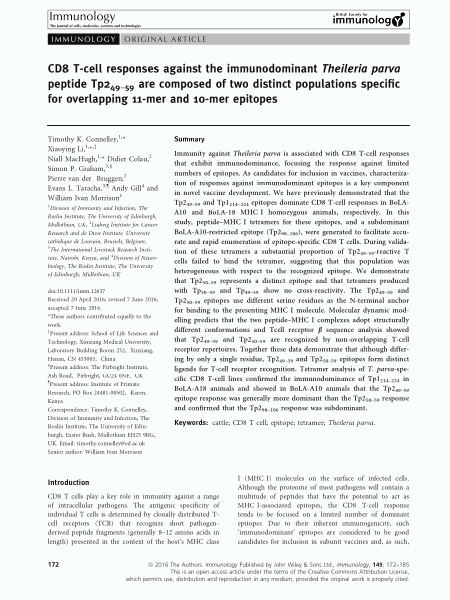CD8 T‐cell responses against the immunodominant Theileria parva peptide Tp2 49–59 are composed of two distinct populations specific for overlapping 11‐mer and 10‐mer epitopes
Abstract
Immunity against Theileria parva is associated with CD8 T‐cell responses that exhibit immunodominance, focusing the response against limited numbers of epitopes. As candidates for inclusion in vaccines, characterization of responses against immunodominant epitopes is a key component in novel vaccine development. We have previously demonstrated that the Tp249–59 and Tp1214–224 epitopes dominate CD8 T‐cell responses in BoLA‐A10 and BoLA‐18 MHC I homozygous animals, respectively. In this study, peptide–MHC I tetramers for these epitopes, and a subdominant BoLA‐A10‐restricted epitope (Tp298–106), were generated to facilitate accurate and rapid enumeration of epitope‐specific CD8 T cells. During validation of these tetramers a substantial proportion of Tp249–59‐reactive T cells failed to bind the tetramer, suggesting that this population was heterogeneous with respect to the recognized epitope. We demonstrate that Tp250–59 represents a distinct epitope and that tetramers produced with Tp50–59 and Tp49–59 show no cross‐reactivity. The Tp249–59 and Tp250–59 epitopes use different serine residues as the N‐terminal anchor for binding to the presenting MHC I molecule. Molecular dynamic modelling predicts that the two peptide–MHC I complexes adopt structurally different conformations and Tcell receptor β sequence analysis showed that Tp249–59 and Tp250–59 are recognized by non‐overlapping T‐cell receptor repertoires. Together these data demonstrate that although differing by only a single residue, Tp249–59 and Tp250–59 epitopes form distinct ligands for T‐cell receptor recognition. Tetramer analysis of T. parva‐specific CD8 T‐cell lines confirmed the immunodominance of Tp1214–224 in BoLA‐A18 animals and showed in BoLA‐A10 animals that the Tp249–59 epitope response was generally more dominant than the Tp250–59 response and confirmed that the Tp298–106 response was subdominant.

